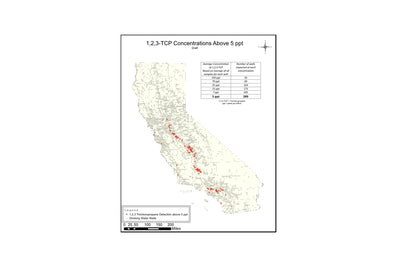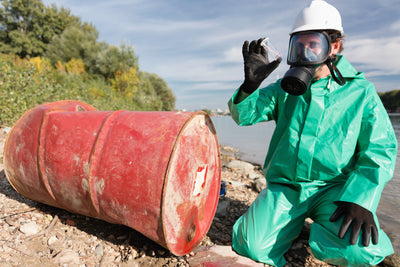Michelle Scire | Scientific Contributor
What Is 1,2,3 Trichloropropane And Where Does It Come From?
1,2,3 Trichloropropane (TCP) is a synthetic chemical that is commonly used as an industrial solvent, cleaning and degreasing agent, and paint and varnish remover. In California’s Central Valley, widespread TCP contamination was caused by a now-banned fumigant DBCP, which was used to kill nematodes (small worms that live in the soil). When applied to the soil, TCP leaches from the deeper soil to groundwater. When DBCP was banned in 1977 by the EPA, it was commonly used on over 40 crops in California. Unfortunately, TCP is persistent in the environment, and as of November 2017, 395 of the 5863 wells used by public water supplies had levels of TCP that exceeded the California regulatory limit. When looking at a map of contaminated wells (above), you will see a strip right up the center of California from south of Bakersfield to Sacramento with some prominent outliers in Los Angeles, San Diego, Salinas, San Jose, San Francisco, and Chico counties.
Why Do We Care About TCP?
TCP is some nasty stuff. In the short-term, high levels of inhalation exposure to TCP can cause irritation of eyes, respiratory tract and skin, and has the ability to depress the central nervous system. Moreover, studies in rodents have confirmed it may affect memory, focus and muscle coordination. Long term exposure studies have found exposure in rodents can lead to liver and kidney damage as well as reduced body weight and tumor growth. To get an idea of how toxic TCP is, the 5 part per trillion MCL (legal limit) is equivalent to a single drop of water being diluted into about 5.5 olympic sized swimming pools!.
Timeline of Public Knowledge Related To TCP Toxicity
|
Year |
Action |
|
1930’s |
Age of chemical agriculture and the beginning of Expts. With DBCP as a fumigant. |
|
1974 |
Dow memo refering to select DBCP components as, “garbage.” |
|
1977 |
Ban of DBCP which contains 1,2,3 TCP except Hawaii. |
|
1992 |
1,2,3-TCP was added to the list of chemicals known to the state to cause cancer, pursuant to California's Safe Drinking Water and Toxic Enforcement Act |
|
1995 |
International Agency for Research on Cancer (IARC) tested TCP for carcinogenicity by oral administration in one experiment in mice and in one experiment in rats. It produced tumours of the oral mucosa and of the uterus in female mice and increased the incidences of tumours of the forestomach, liver and Harderian gland in mice of each sex. ln rats, increased incidences of tumours were observed in the preputial gland, kidney and pancreas of males, in the clitoral gland and mammary gland of females and in the oral cavity and for stomach of both males and females. |
|
1995 |
Maximum contaminant levels (MCLs) have been established or are proposed at the state level in Hawaii, California, and New Jersey (ATSDR 1995). |
|
1999 |
California State Water Resources Control Board established a 0.005-micrograms per liter (μg/L) drinking water notification level for 1,2,3-trichloropropane (1,2,3-TCP). This value is based on cancer risks derived from laboratory animals studies (US EPA , 1997). |
|
2001 |
California State Water Resources Control Board began monitoring TCP vie the UCMR analytical method but no regulations of corrective actions put in place |
|
2004 |
California State Water Resources Control Board requested a public health goal (PHG) from the Office of Environmental Health Hazard Assessment (OEHHA). A PHG is not a enforceable parameter for TCP but merely a goal. |
|
2007 |
OEHHA released a draft PHG (0.0007 µg/L) and technical support document |
|
2009 |
OEHHA established a 0.0007-ug/L PHG for TCP. |
|
2009 |
EPA Integrated Risk Information System (IRIS) lists chronic oral reference dose (RfD) of 4 x 10-3 milligrams per kilogram per day (mg/kg/day) and a chronic inhalation reference concentration (RfC) of 3 x 10-4 milligrams per cubic meter (mg/m3) (EPA IRIS 2009). The cancer risk assessment for TCP is based on an oral slope factor of 30 mg/kg/day (EPA IRIS 2009). |
|
2013 |
No federal Maximum Contaminant level (MCL) set for TCP in drinking water. |
|
2017 |
State Water Resources Control Board voted to approve a standard for the chemical in drinking water. They set the limit at 5 parts per trillion, a level supported by clean water and pesticide reform advocates. The state will now start water systems to test all of their wells every month starting in January 2018. |
Data from: HERE
What Took Regulation Of TCP So Long?
While it’d be great if regulatory bodies were able to act quickly, the reality is that regulations take time, often decades to execute. In the case of TCP specifically, Cindy Forbes, the deputy director for Californiawater board’s drinking water program, insists that TCP regulation was a “top priority,” but explained that they had limited resources preventing them from reaching“the finish line.” In California, the process to establish a maximum contaminant level (ie regulatory limit) includes: conducting their own peer-reviewed research, evaluating cost of detection and cleanup, as well as allowing public comment (which undoubtedly includes comments from companies responsible for contamination). Forbes claims, “It’s my priority, it’s the board’s priority,” but one has to wonder what the word priority means when there is scientific research going back 25 years explicitly showing the repercussions of this contaminant. There is only one carcinogen with a lower state public health goal for drinking water, and that is dioxin.
What Can Be Done To Treat Water That Has Been Contaminated With TCP?
Large Scale TCP Remediation Techniques
Because of the contamination primarily leaching into the ground water in California's Central Valley, ground water remediation methods have been established. TCP can be removed with traditional methods such as, “pump and treat granular activated carbon filters (GAC), in-situ oxidation, permeable reactive barriers (zero-valent zinc), dechlorination by hydrogen-releasing compounds, and emerging biodegradation techniques.” A new method was developed recently using, “in-line, pressurized advanced oxidation process (HiPOx) that has the ability to remove TCP from groundwater to below 0.005 μg/L.” The treatment techniquewill depend on the level of contamination in groundwater or soil being treated. While these methods are indeed effective, they are expensive and require long planning/execution periods.
Small Scale (Residential) TCP Removal of TCP
If your home’s water is contaminated with TCP, and large-scale treatment isn’t happening in an acceptable time frame, some residential water filters do remove TCP. Our advice is to find a water filter that is advertised to remove volatile organic compounds (VOCs), and ask the manufacturer for a data sheet that shows effective removal of TCP specifically.
If you have any more questions about 1,2,3 Trichloropropane contamination, we encourage you to reach out to our “Help No Matter What” technical support through live chat or email (hello@hydroviv.com). Our Water Nerds are happy to answer any questions you may have!
Other Articles We Think You'll Enjoy
What Should I Know About Removing VOCs From My Water?Why Are Toxic Chemicals In Drinking Water?
What Endocrine Disrupting Chemicals Are Commonly Found In Drinking Water?





